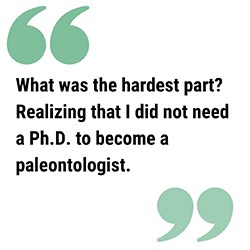Last updated: January 27, 2022
Article
Dare to Imagine: ReBecca Hunt-Foster

Women Lifting Other Women
I am both inspired by the people who came before me and have worked hard to preserve this great park I have the opportunity to work in, but also the prehistoric animals themselves, who, without interested learners, might not ever be studied, or known. This knowledge helps color the history of our world, giving depth of time to life on this planet, and serving as a gateway science to both young and old individuals.
-ReBecca Hunt-Foster
ReBecca, what project would you like to highlight?
I would like to highlight Paleontology and Museum Sciences, through the lens of process and collections. We have been working to upgrade our museum collections. Often museum collections, such as fossils, are thought of as being excavated and then on display, but the cleaning and collections management aspects are often overlooked. Highlighting these important aspects in the context of the story at Dinosaur National Monument, where we hold a world renowned fossil collection that fell into neglect and disrepair, can help highlight the work taking place to improve collections, making them more accessible to researchers and meeting National Park Service standards.

Will you tell us a little about the project?
Dinosaur National Monument's paleontological collections represent the primary resources addressed by the original 1915 monument enabling legislation. These collections are mission critical because paleontology is the primary and only resource identified in the Monument’s original enabling legislation. The Monument’s primary and most critical mission is to conserve and interpret its fragile fossil resources, which are curated in the Monument’s museum collection. Many of the specimens held in the monument’s collections are rare or unique fossils that have not been identified anywhere else on the planet. Some specimens are still in their original field jackets and have not been cataloged or received any conservation treatments after a decade or more, and were being stored in poor conditions, putting these resources in serious danger.
How did you get to where you are now? What was your path like?
In graduate school I had the opportunity to work in Big Bend National Park, which really reaffirmed my love for our public lands. After earning my Masters Degree at Texas Tech University in 2005 I worked in Glacier National Park as a paleontologist for a summer before moving to Augustana College, where I worked as a paleontology research assistant for 3 years. I then moved to the Museum of Western Colorado's Dinosaur Journey Museum, where I worked as paleontology collections manager and field lead for the next 4 years. Afterwards I took a job with the Bureau of Land Management as district paleontologist in Canyon Country District, located in southeastern Utah, where I worked for five and a half years before moving on to Dinosaur National Monument in 2018.
What was the hardest part about getting to where you are now? How did you overcome it?
Realizing that I did not need a Ph.D. to become a paleontologist. I had the opportunity to do a variety of career and skill building jobs that have lead me to my current position. It took much persistence, support and tenacity, but the wonderful community I have in paleontology and beyond was both encouraging and inspiring to keep me moving forward.

What are you most proud of?
Meeting (and occasionally exceeding) my goals to become a paleontologist, while also managing a wonderful home and family life.
Favorite Quote?

